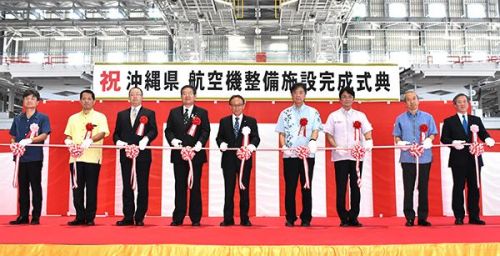MRO facility relocates to Naha airport, anticipates demand

Governor Denny Tamaki (center) and president of MRO Japan Kiyoaki Arakawa (second from left) pose at the ribbon-cutting ceremony at MRO Japan at Naha Airport on Nov. 8.
November 9, 2018 Ryukyu Shimpo
Okinawa prefecture hosted a ceremony on Nov. 8
to celebrate the completion of a new aircraft maintenance facility operated by MRO Japan at Naha airport.
The MRO facility has relocated from Osaka International Airport (Itami Airport) and will be operational beginning January 2019.
Naha Airport had the third highest number of flight routes among domestic airports in fiscal year 2016.
Due to increased volume in low-cost airline flights and domestic flights, higher demands in aircraft maintenance is expected.
Naha Airport is conveniently located for flights to and from Asia and is competitively positioned to answer to foreign demands; availability of Japanese-quality maintenance, an abundance of young labor as well as the warm climate allowing for undemanding maintenance were all deciding factors for relocation.
Local authorities expect the economic effects of the aircraft maintenance facility to reach 29.1 billion yen in the next decade.
Employees will be hired locally—the facility has employed 60 locals so far and has extended official offers to an additional 24.
They aim to hire around 400 employees.
The prefecture has invested 18.7 billion yen of its public works spending in building the maintenance facility.
The site is 29,396 square meters in size, while the hangar bay measures 189 meters wide and 99.85 meters deep.
It can accommodate one medium to heavy aircraft and three small aircrafts.
“We expect derived demand in parts manufacturing and repair,” said Governor Denny Tamaki.
“We have taken a step toward a new era for Okinawa, in which we will lead Japan’s economy.”
Azusa Sekkei president Fumihiko Sugitani, who also designed and supervised the project, further explained the resilience of the facility, which is “designed to withstand natural hazards including typhoons and salt sprays.”
(English translation by T&CT and Monica Shingaki)
Previous Article:Gov. Tamaki calls for trilateral talks with Japanese and US governments to resolve Henoko relocation issue
Next Article:US aerial tankers fly to MCAS Futenma, Ginowan residents complain of noise intensification
[Similar Articles]
- ANA asks the OPG to build a maintenance base at Naha Airport
- MRO Japan begins servicing planes at Naha Airport, will work on 20 planes through March and plan to take orders from Asia
- Mitsubishi Estate commences work on Shimojijima Airport scheduled to open in March 2019
- Peach Aviation begins its first flight from Okinawa
- New Naha Airport International Terminal to open next February
 Webcam(Kokusai Street)
Webcam(Kokusai Street)


